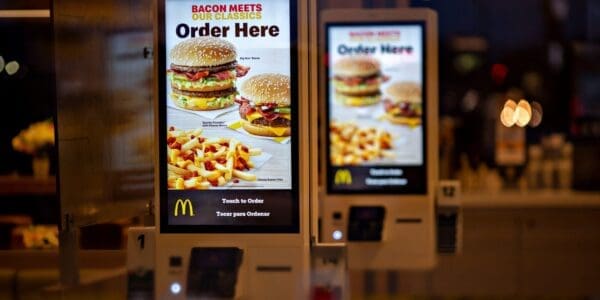However, we speculate it’s only a matter of time before that changes. Currently, the average labour cost for a restaurant as a percentage of its gross sales is about 30 – 35%. Restaurant managers are always looking to reduce their labour costs and have been for decades, but during that time the same advice has always been touted – “invest in automation!”.
It’s such a popular suggestion because it’s actually true – but once you’ve heard it, it’s no more useful to hear it a second time and by now will sound like a broken record to many restaurateurs. Besides, what exactly does ‘automation’ mean today anyway?
(Spoiler: It’s probably not what you think.)
The idea of food outlets totally replacing human labour with software and machines feels a little science-fiction, but it’s a reality we’re edging towards faster than you’d think. Restaurant technology has progressed leaps and bounds over the last decade and it’s is being integrated into the workplace in newer and more innovative ways than ever before.
In that vein, we’ve put together a couple of novel ideas to help you try and reduce restaurant labour costs, boost productivity or update your workplace practices
1. Add a little artificial intelligence
Tools like Kitchen display systems (KDS) and electronic points of sale (EPOS) have become invaluable to the operations of many food outlets, from fast food to Michelin stared. By speeding up processes both at front- and back-of-house, they’ve help to hugely reduce restaurant running costs long-term. However, these systems are almost a standard now which means all those additional gains in efficiency have been had So what comes next?
It seems that artificial intelligence is the upcoming revolution in restaurant tech (as with all other tech too!). It might not be immediately obvious where and how it could be applied but once you start to think about it, the many potential benefits it presents for reducing restaurant labour costs becomes clear. Vita Mojo OS already utilises AI in some great cost-saving ways.
For example, the software provides live analytics from operations including customer feedback and behaviour, all facilitated by AI. This information allows less experienced staff to make more informed decisions; so the amount of time a task takes is reduced as well as the risk of mistakes.
The integration of AI can also help with the costs of training new staff. Having software like Vita Mojo OS in place provides assistance to those newer staff members, guiding them towards making the right choices and delivering a better customer service. This means fewer hours of training is required per team member, saving time and money without compromising on the end product enjoyed by the customer. It really doesn’t get more intelligent than that.
2. Design your back-of-house just right
There’s no single right way to design a commercial kitchen but a poorly designed one will decrease productivity, increase wait times and impact employee turnover. Finding the best layout for your back-of-house operations ultimately depends on what’s on your menu.
Keep the steps for prepping your meals in mind; how does each station relate to one another? Should the salad prep station be near the hot plate? Does the deep fryer make more sense on the right or the left side of the range?
You’re unlikely to be able to cook every element of every meal in the same order every time, so the next best thing is to work out your most frequent ‘order of prep’. Find the sequence where meal elements are prepped and added to a dish in the same order, across the largest number of meals.
Prioritise that process as the foundation for your kitchen layout and it will allow you to make the decisions about the most efficient way to place your stations and equipment.
We also recommend thinking about how much space there is between stations to allow chefs to pass each other, whether you’ve got enough of every utensil even at peak times and how easy it is to reach the elements that correspond to each station. Achieving a high ratio of food quality to speedy service merely relies on having a properly outfitted, well laid-out kitchen.
3. Streamline your communications
Miscommunication between staff, whether that’s between chefs and waitstaff, waitstaff and other waitstaff, chefs and dishwashers, is a huge source of wasted time and resource. It takes time to make a mistake, correct it, have it re-explained and then re-do it. Therefore, one easy way to reduce restaurant labour costs is simply to eliminate the opportunities for that to happen.
With the most common point of miscommunication being between front and back of house it makes sense to have a solution that focuses on bridging that gap. The best thing for that is having all front of line staff working off of one centralised system together.
Vita Mojo OS offers a platform which works across all areas of restaurant operations including between EPOS machines at the front-of-house and KDSs in the back. Linking the two areas together with software drastically lowers chances of human error happening. Each order made by the customer is sent directly to the kitchen, where it’s clearly displayed on easy-to-use kitchen display screens and coupled to a food assembly system for even greater ease.
Not only can software like this do wonders for streamlining communication between staff but it can also help increase total throughput, manage live capacities and provide built-in stock management. Combined, there are so many ways Vita Mojo OS can be implemented to reduce restaurant labour costs.
For the full picture of what Vita Mojo OS can do, head over to our product suite page where you check out more info and even apply for a demo. You can read more about What is Vita Mojo OS in some serious detail over on our blog too, talking all about the benefits of using software to improve restaurant operations.
Read more on how technology in the restaurant industry can help improve your customer experience.
Let us know your thoughts about these ideas in the comments below and share some of the ways you’ve noticed get overlooked for helping reduce restaurant labour costs.


